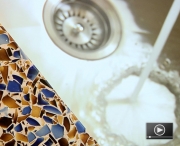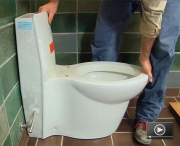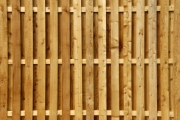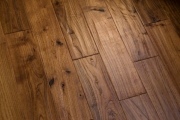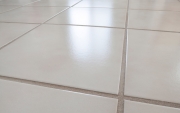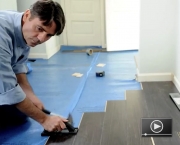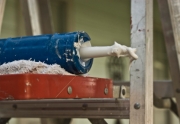- Error
{Re}habitat
Learn how adaptive reuse and upcycling can add hip design to your home, apartment, or yard with the Go Green channel's {Re}habitat series. Follow host Rachael Ranney as she shows you how to repurpose salvaged and found materials, adding fun and function to your space without breaking your budget.

Countertops not only provide the main work surfaces in a kitchen, but they also offer an opportunity to add a splash of color and materiality to the space. With the nearly limitless design options for countertops, choosing the material and color is often the most difficult part of installing new kitchen countertops. Depending on the type of material, fabricating a kitchen countertop can be a challenge for a do-it-yourselfer, but installing the countertop is a project almost any do-it-yourselfer can handle. Join the At Home channel's host, Jeff Wilson, as he completes the kitchenette and offers tips on installing a recycled glass countertop.
Many puns have been applied to toilet replacement and installation, but in reality replacing or installing a toilet is a pretty simple home improvement project for a do-it-yourselfer. The workings of a toilet are contained within the fixture itself, so the installation comes down to making a couple of plumbing connections, one for the water supply and one for the waste drain. Join the At Home channel’s host, Jeff Wilson, for a video guide through the process of installing a toilet.
In 1914, Robert Frost wrote, in his poem Mending Wall, "Good fences make good neighbors." You may choose to build a privacy fence on your property for any number of reasons: to increase safety, privacy or security; enclose pets or children; eliminate sight lines beyond your property; or simply to enhance your home's curb appeal. Once you gain an understanding of the materials required as well as layout and installation techniques, building a wood privacy fence is a job many do-it-yourselfers can accomplish.
Wood flooring is a long-lasting, aesthetically pleasing, and affordable interior floor covering. According to the National Wood Flooring Association (NWFA), "In a national survey of real estate agents, 90% said that houses with wood flooring sell faster and for higher prices than houses without wood floors." That being the case, who wouldn't want a wood floor? Prior to racing out and purchasing wood flooring, we need to understand what is available and keep in mind that all wood floors are not created equal.
Tile floors are an extremely durable, long-term investment that should be regularly cared for to preserve both their appearance and value. In fact, a well cared for tile floor can last a lifetime. According to the Study of Life Expectancy of Home Components, which was prepared in 2007 by the National Association of Home Builders (NAHB), the average life expectancy of a ceramic tile floor is 75 to 100 years, while natural stone such as marble and granite can last more than 100 years.
Tile flooring is manufactured from a variety of materials such as clay, stone, metal, terrazzo, and quartz. Each type of tile flooring has its own defining characteristics. Generally speaking, the two most commonly used types of tile flooring are ceramic and natural stone.
Laminate flooring has become a very popular choice for do-it-yourselfers due to the fact that it’s economical, durable, and easy to install. Several varieties of laminate wood flooring are available, offering consumers a vast array of aesthetic choices. Most laminate flooring products share similar characteristics: a pressed wood base; a durable, adhered laminate finish; and a self-locking tongue and groove system. These systems typically do not require fasteners or adhesives – they just lock into place, basically “floating” above the subfloor. Join the At Home channel host, Jeff Wilson, for a tutorial on installing a laminate floor.
Preventing water damage inside our bathrooms is just as important as directing water away from our homes. Caulking, as part of routine homeowner maintenance, prevents avoidable damage around the multiple fixtures and different building materials located inside a bathroom. To get started all you need to know are the areas inside a bathroom that need to be regularly maintained, how to remove existing caulking, and how to apply a new bead of caulk.
